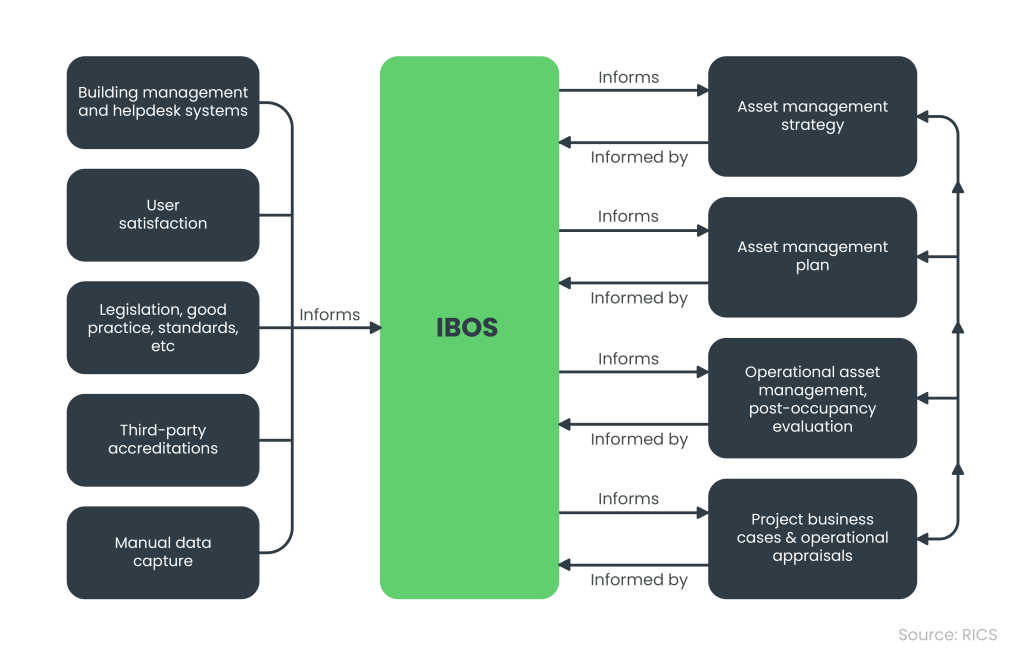The world has been in a state of flux since the pandemic. Technological trends have accelerated, with a greater focus placed on remote working and building safety. Combined with the ever-widening commitment to minimising harmful environmental impacts, there have been great changes in people’s behaviours and priorities.
With the Royal Institute of Chartered Surveyors (RICS) taking the lead, those with property management responsibilities have responded by adopting a multidimensional and people-centric approach to assessing performance.
Introduced in February 2022, the International Building Operation Standard has been designed to reflect changes in the role of buildings and how they are consumed. While factors such as structural safety and cost remain critical, IBOS places a new focus on the ways that buildings influence and affect those who use them.
Read on to learn more about the ways that this new standard is enabling the measurement of building performance in terms of user experience.
What is The International Building Operation Standard (IBOS)?
IBOS, which stands for The International Building Operation Standard, was introduced partly in response to challenges and shifts in perspective following COVID-19. RICS Tech Partner Rob Jackson emphasised that this has created the opportunity for change across the environments that people want to live and work in.
Combined with the increased focus on sustainability, this has forced asset owners to think about the kinds of environments and workspaces that they need to create to cater for evolving occupant needs. IBOS reflects the changed mindset by focusing on:
- Talent retention
- Wellbeing
- Environmental performance
- Social value
Endorsed by large office occupiers, universities, service provider firms and government departments, IBOS allows for the measurement of building performance across a range of categories. The RICS framework specifies that this can achieved through the capture of raw data from real-time systems, building surveys, documents, and other one-off or periodic exercises. Focusing on aspects of user experience such as the impacts on mental health, IBOS extends beyond the scope of other methods.

Who is IBOS for?
IBOS has been designed for the use of all property sector professionals looking to holistically measure building performance. However, the IBOS framework makes a clear distinction between internal and external stakeholders.
The category of internal stakeholders includes:
- Service Providers
- Customers
- Investors
- Members of the public
- Landlords/tenants
- Business Partners
- Authorities.
The category of external stakeholders includes:
- Occupiers
- Occupier representatives
- Senior Management
- Asset team/advisors
- H&S Representatives.
With such a variety of stakeholders and a broad range of relevant data, the uses of IBOS may include:
- Internal portfolio benchmarking
- Portfolio comparison against those of other parties
- Day-to-day and strategic asset management
- Data optimisation
- Sustainable asset performance
- ESG reporting
- Strategic portfolio planning
- Capital planning and prioritisation
- Workplace and workforce planning
- Post-occupancy research
- Compliance assessment and
- User satisfaction assessment.
What are the five key pillars of IBOS?
IBOS allows for the consistent measurement of building performance across the key pillars of compliance, economics, functionality, sustainability, and performance. These criteria can be assessed regardless of the property type or location. They are all known to have a bearing on investment portfolio-level metrics and success.
Compliance
A building may be assessed to establish how well it complies with relevant items of legislation, best practices and guidance. This might involve the assessment of environmental factors such as the level of ventilation and air quality. Landlords and service providers are expected to review and act in the best interests of the building occupants.
Compliance ratings may be given based on the analysis of data including:
- Temperature readings
- CO2 level
- Air flow
- User satisfaction
- Incident logs
- Findings and recommendations from audits
- Risk assessments and recommendations
- User concerns and issues raised.
Economics
The costs of occupancy and long-term capital investments are among the operational and life cycle costs that should be captured and reviewed. Occupancy costs may include those incurred by landlords and re-charged via service charges or similar. Capital investment projections may be based on an assessment of the property’s condition and expectations in terms of maintenance and improvement.
The following data may be reviewed in economic terms:
- Costs
- Condition assessments
- Backlog maintenance
- Costed CAPEX plans
- Asset strategy
- Maintenance records
Functionality
Functionality encompasses building resident expectations in relation to connectivity, configuration, flexibility and utilisation. The user experience and effectiveness of FM and asset management services may also be taken into account. This might involve reference to data on the quality and capacity of infrastructure, the capability of the mobile and internet offering, and user satisfaction with the landlord’s approach to digital connectivity.
Functional assessments may involve analysis of the following data:
- User functional requirements
- Occupancy levels and utilisation
- Workspace protocols
- User satisfaction
- Business continuity plan (BCP)
- BCP testing regime
- Recommendations arising from tests
- ICT infrastructure availability
- Incidence of failure.
Sustainability
A building’s environmental performance may be considered in terms of decarbonisation, energy use, waste, social impact, accessibility and transport arrangements. There may also be a comparison with environmental policies and strategies.
Sustainability performance may be established in reference to the following data:
- kWh energy consumed
- Proportion of energy from sustainable sources
- Litres of water consumption
- Cost of utilities
- Net zero carbon strategy
- CO2 emissions
- Environmental rating or equivalent
- Volumes and types of waste disposed of
- Methods of waste disposal.
Performance
The IBOS framework defines performance as the ability of the building – and the way it is managed – to effectively support the performance, satisfaction, user experience, health and well-being of occupiers.
Performance may be judged based on the following types of data:
- User sentiment survey results
- User experience ratings or equivalents
- Responsiveness of FM services
- KPIs relating to responsiveness
- Well-being
- User satisfaction.
The asset manager should collect all relevant data in line with best practices and associated standards (such as the RICS Property Measurement Standards for measurement). The collected data should also be compared with established best practices, benchmarks, and operational targets.
Such consistent assessment should allow for the identification of outstanding performance, as well as any aspects that can and should be improved. Findings may form the basis for decisions on ESG and sustainability, together with building optimisation and user experience.
Performance may be measured against the pillars as follows:
- Establish the pillars against which performance is to be assessed, noting that maximum benefit is obtained by adopting all pillars.
- Capture and analyse data for each asset and performance indicator.
- Capture and analyse the processes by which that data is itself captured and analysed.
- Undertake a gap analysis, ensuring that the data or performance metric is compared to relevant benchmarks, statutory requirements, good practice guidelines, etc. and any gaps identified, and the processes for capturing, analysing and reporting on data or performance metrics are compared to best practice, and any gaps identified.
- Prepare a value creation plan to close any gaps, with costs and benefits identified.
- Identify and report on the outcomes achieved.
How will IBOS play a role in the future of building standards?
IBOS has already become a key reference for property management professionals and proptech companies, and it’s adoption is only set to increase with the integration and use of the RICS IBOS self-assessment tool (SAT). This digital self-assessment allows for consistent measurement against the key indicators, with a percentage-based report and assessment being generated for download.
IBOS also adds an extra layer to the property auditing process, ensuring the review of long-term operational management costs. It places a greater focus on user experiences, with customer feedback required for the completion of IBOS surveys. Besides making for a more holistic view of building performance, it also allows for the plugging of data gaps.
The recognised value of the IBOS survey is likely to increase, as integration of the application programming interface enables automated completion. This is also bound to become a feature of proptech solutions, meaning that more time can be spent on activities for optimum resident satisfaction.
IBOS can be seen as part of a wider theme of dynamic change, in which old models are redefined, and older buildings are brought up to pace with modern, new builds, something which is stressed by Andrew Knight, Global Data and Tech Lead at RICS.
“With most real estate assets already built, it is critical that the sector focuses on measuring, managing, and improving the energy and sustainability performance of these existing buildings,” Andrew Knight said.
“IBOS enables asset owners and operators to start their journey to smarter buildings with a clear and simple framework of what to measure, and how to use these common-sense metrics to improve the performance of their assets. whilst at the same time, focusing on the quality of the experience of the people of use them.”
This, ultimately, will make for a new built environment where the focus is on sustainability, customer-centricity, and people-centricity. It’s a vision that can only be realised through the data-driven measurement of building performance.










